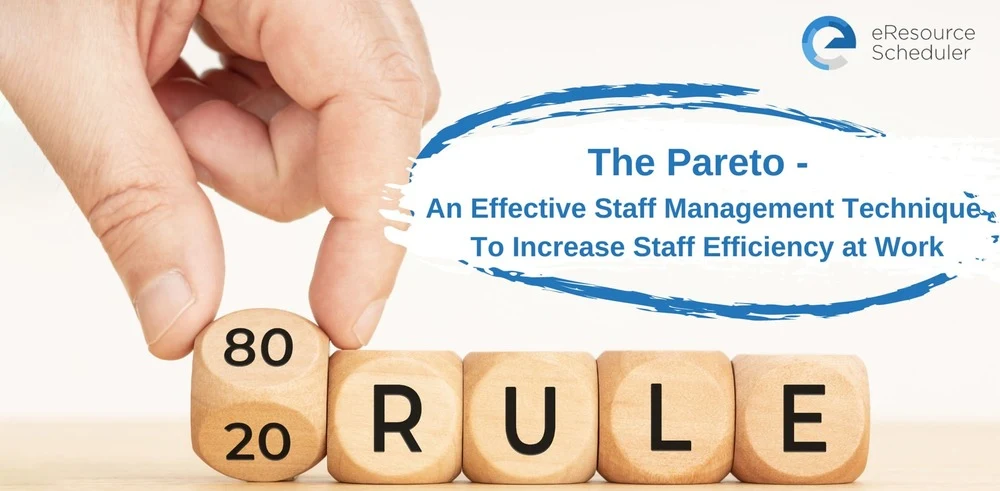
According to the Pareto principle (also called the 80/20 rule), 80% of outcomes are caused by 20% of causes.
What is the first thing you do when you arrive at work? Many of you prefer grabbing your cup of coffee, checking your emails, and prioritizing the tasks for the day. But how will you identify what needs to be prioritized?

Pareto's principle, or 80/20, is among the most common techniques. The Pareto principle is one of the numerous productivity techniques that can benefit you and your employees. The goal is to work smarter rather than longer or harder.
If you've attempted other productivity methods to enhance the company's time management skills, you might have been unsuccessful. Companies are befuddled by complexity as they serve multiple markets with multiple products. Similarly, many of us have daily to-do lists that seem impossible to complete in today's fast-paced world — but don't give up before applying the Pareto principle.
The Pareto principle will help managers to achieve more with fewer efforts.
According to the Pareto principle, for many results, roughly 80% of the consequences occur from 20% of the causes. In other words, a significant fraction of the reasons has a disproportionate impact. This concept is crucial to grasp because it can assist you in determining which initiatives to prioritize to have an effect.
"Work smarter, not harder" is the Pareto principle. To increase productivity, Pareto enthusiasts believe the key is to identify and capitalize on the 20% of efforts that produce 80% of the results.
Other names for this phenomenon include:
The Pareto principle or 80/20 rule is not a mathematical formula but a more generalized approach used in economics, business, time management, and sports.

The Pareto principle was created by Italian economist Vilfredo Pareto in 1896. While gardening, he noticed that 20% of his pea pods produced 80% of the peas.
The 80/20 rule was devised by Pareto to simply explain how this phenomenon is possible. To summarise, not all wealth is created equal because not all work results in the same return on investment.
Later, Dr. Joseph M.Juran clarified that people can apply the Pareto principle rule in other work areas. He put forward the Pareto principle after successfully applying Pareto's law in operations management.
The Pareto rule can be applied anywhere to boost efficiency and output. Analyze which 20% of the effort, time, or money produces 80% of the results using performance metrics. Then double the efforts for that 20%.
Suppose you have work that can be divided into smaller segments. In that case, the Pareto principle can help you determine which portion is the most influential.
The Pareto principle is not rocket science, and it is hard to believe initially. Still, it is recommended to try it once.
Now that you are aware that the Pareto principle impacts business productivity, it is equally important to know how to create effective change through the Pareto principle.

The 80/20 rule can transform your business in several ways, including
Business owners can use the 80/20 rule to prioritize tasks.
The theory is that achieving 20% of the tasks on the list will result in 80% of the impact decision-makers can create for that day. So, to get the most out of the day, identify which tasks impact the team and optimize them.
To accomplish this, determine which of these tasks has the most significant impact. Does any of your work require you to collaborate with others? Do you have any tasks on your plate that are hindering the progress of your projects? These tasks may be simple to complete, but they can significantly impact the rest of the team by enabling the process to continue.
During the problem-solving process, the Pareto principle can assist in making the best decisions. When there are possible causes of a single problem, the Pareto principle can assist in achieving solutions. Here are some examples of how this works:

The Pareto principle is not only suggested for managers or CEOs, but employees can use this strategy to manage their own time. These tips can help them irrespective of whether they're looking for a promotion or want to perform better at their job.
Employees who deliberately seek professional opportunities do not stand in line for their boss to assign them tasks; instead, they identify problems and propose solutions. Such employees can use the Pareto Principle to determine which of their daily tasks demand attention and what new opportunities they can pursue to increase that 80% output.
For employees, their responsibilities were inherited before they worked in that organization. For such employees, there are good chances that some tasks are time-consuming with no significant results.
Using the 80/20 rule, they can prioritize their work. Suppose a task fails to produce the desired results. In that case, an employee can ask their manager about assigning the task or even obliterating it from their job.
Managers can adjust one's roles to best match company goals if they demonstrate to their bosses why something is a waste of time. This indicates that personnel is innovating and considering ways to work smarter with time.
The Pareto Principle can assist employees in closing the deal on a raise or promotion. They can list their accomplishments from the previous year, such as revenue-generating projects, any accounts they assisted in closing, and so on. Identify and capitalize on everything that falls into the 80% of company growth.
Allow the manager to analyze how it impacted the company's highest growth areas. Consider taking on new responsibilities! Make it simple for managers to understand your worth. Demonstrate that you are among the top 20% of their performers.

Being a manager using the Pareto principle is like wielding a double-edged sword. This helps managers point out their high performers, but it also makes a few employees feel left out. For managers, perfecting this balancing act is crucial.
The 80/20 rule is ideal for forecasting goals and the company's overall vision. Managers can sit with their team members and determine what 20% of the project drives a successful result.
Once the managers strip away the processes that fail to drive results, they can help their team to focus on what's important.
For a manager, the biggest mistake is that they only focus on 20% of their high performers. Managers must refocus on workloads based on who produces the best results. Assign the top 20% of employees to the most critical projects and tasks, and let the pragmatic performers handle the other 80% of the work.
And, of course, keep track of everything. These delegated tasks can become lost and muddled without the proper tools. Managers can assign tasks to employees and track project progress in one place using staff scheduling software.
The Pareto Principle provides managers with a lens to view daily workflows. Managers employ this time management strategy to concentrate on tasks that increase revenue, improve employee performance, and increase overall productivity.
One of the most significant advantages businesses gain from the Pareto principle is that they can successfully achieve the most with the least effort. This allows the teams to work more efficiently and stay focused.
The 80/20 rule can help increase business metrics in less time by prioritizing the work.
Additional benefits of using the Pareto principle include:

The Pareto principle is a theory, not a set of rules. It is effective in some situations, but it is not appropriate in others.
When using the Pareto principle, be cautious. There are a few instances where the 80/20 rule fails.
Fortunately, we have tools to manage this 20% high-priority work.
Finding new initiatives to schedule efficient employees and boost productivity is crucial for team leaders. Staff scheduling software can assist you in determining how to seamlessly assign tasks to each team member.
With eRS staff scheduling software, managers can schedule resources with real-time availability data. The resource availability data helps managers know how many are wasting time (80%) and how many are utilizing time (20%).
Finding different ways to assist your team in delivering projects on time and within budget is essential to being a team leader. Staff scheduling software such as eRS can help you organize your team, minimize scheduling efforts, and gain information on under and over-utilized resources.
Plan Smarter. Schedule Faster.
Join thousands already using eResource Scheduler to align teams, time, and tasks seamlessly.